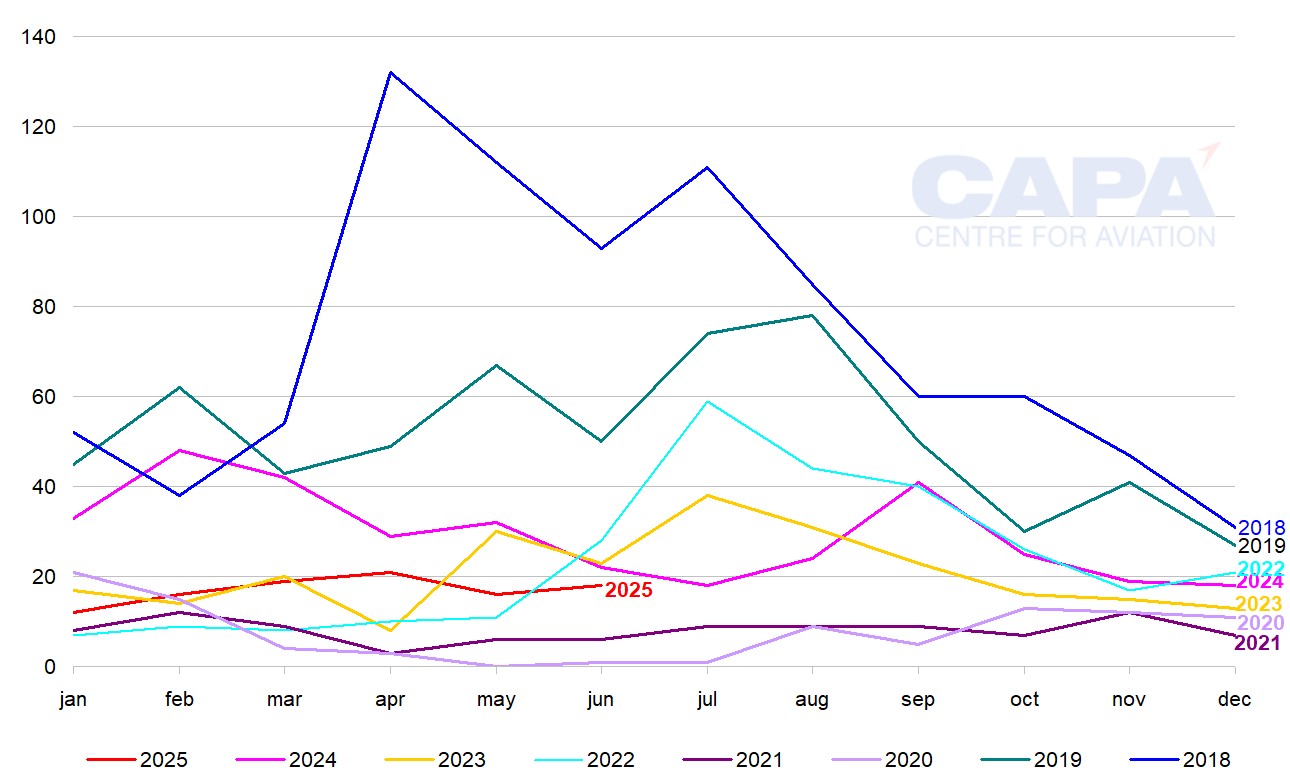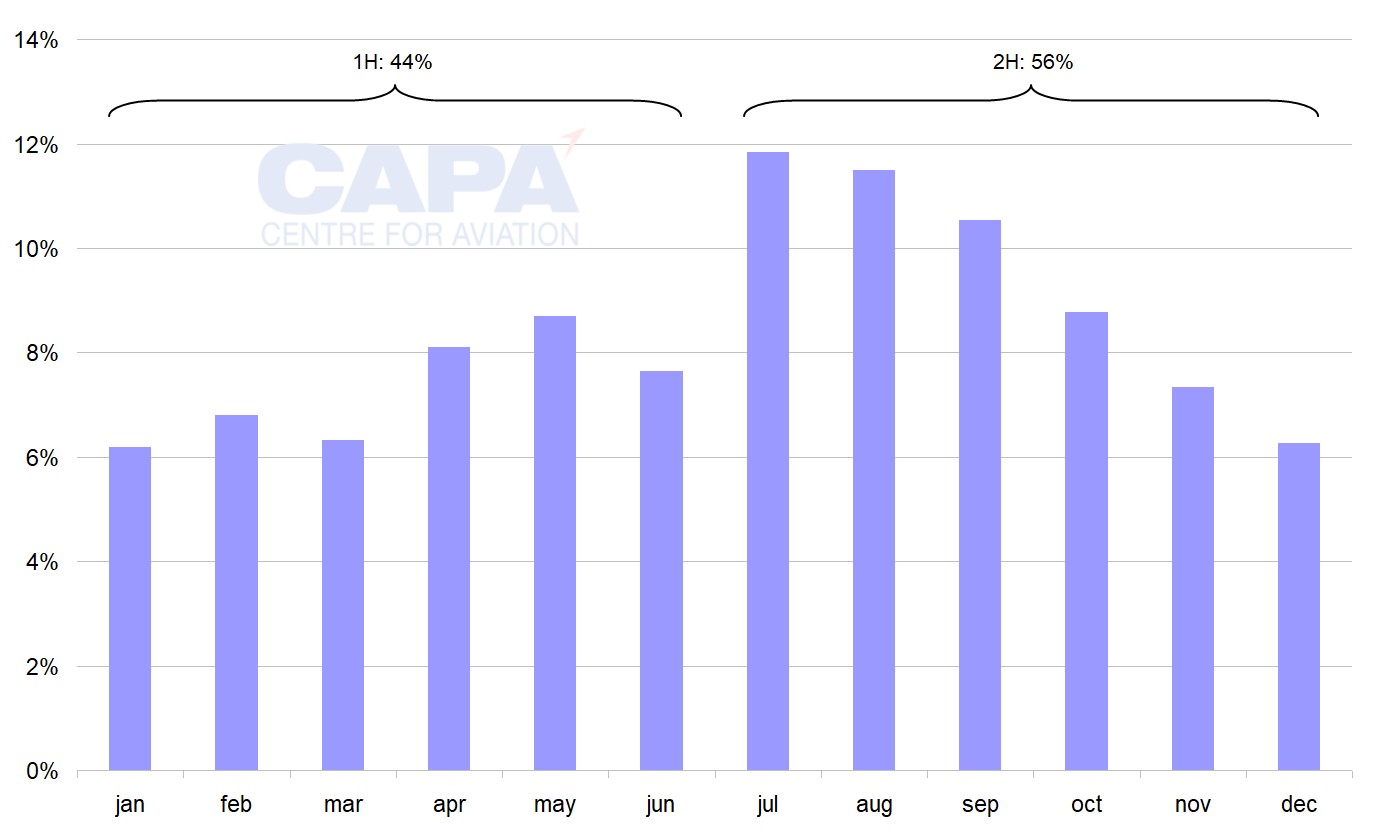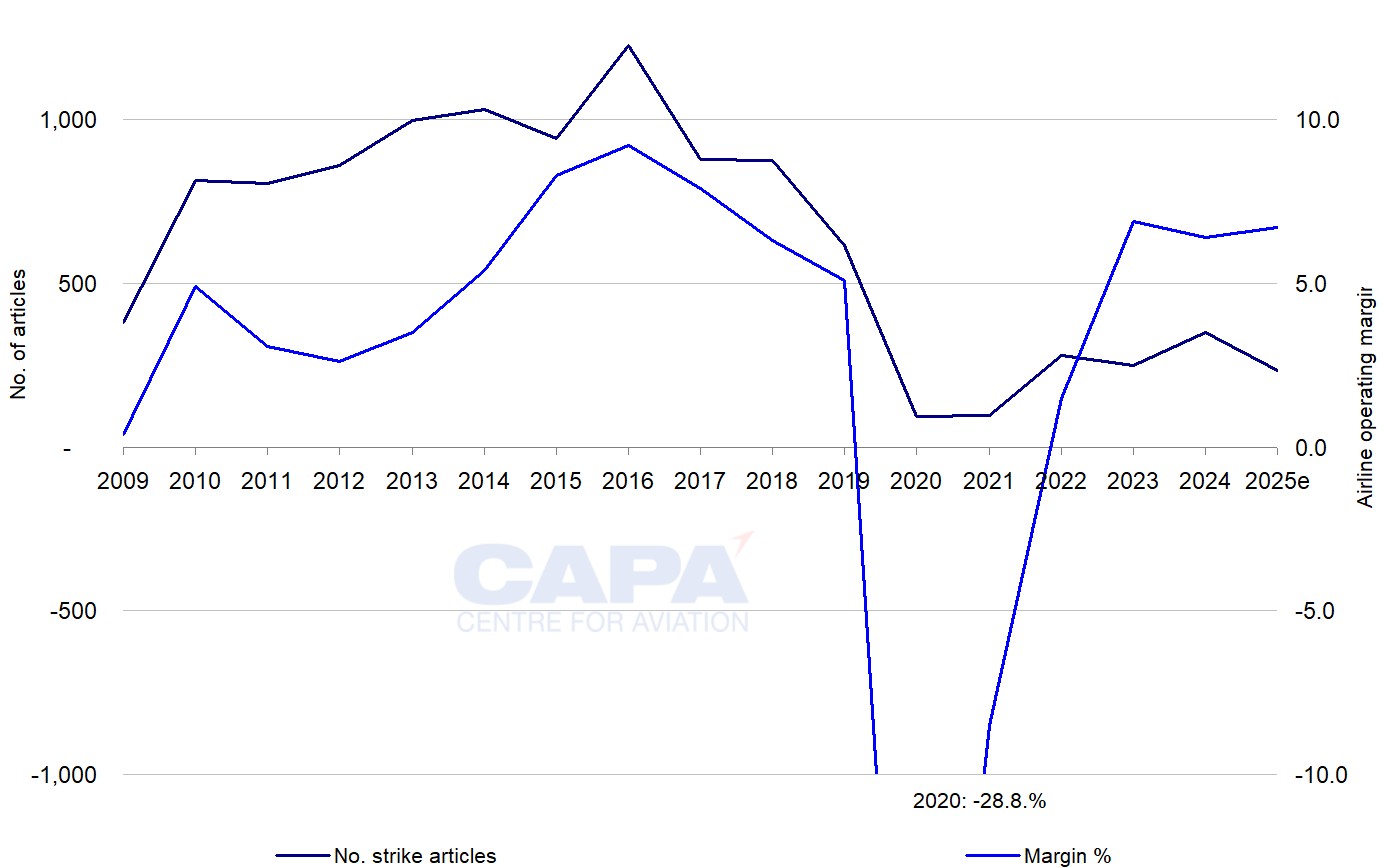The confidence of aviation labour organisations to claim a greater share of industry profits when margins rise appears to be lower than it was before the COVID-19 crisis.
Historically, the number of news articles on the CAPA – Centre for Aviation website mentioning the word ‘strike’ has broadly followed the rise and fall of airline industry operating profit margins.
However, the number of CAPA – Centre for Aviation ‘strike’ articles has not increased in line with margins in the aftermath of the COVID-19 pandemic.
Moreover, in spite of IATA’s forecast of a slight margin improvement in 2025, the number of articles halved in 1H2025 versus the same period of last year 2024.
Summary
- The number of CAPA – Centre for Aviation ‘strike’ articles peaked in 2016, and collapsed during the COVID-19 crisis. 2024 was still 43% below 2019, while 1H2025 was one third of 1H2019.
- Strike article numbers typically peak in July, August and September (during the northern summer).
- The annual number of ‘strike’ articles has varied with the airline profit cycle.
- But for 2025, although a slight margin improvement is forecast, the ‘strike’ article count seems unlikely to grow.
The number of CAPA ‘strike’ articles peaked in 2016, and collapsed during the COVID-19 crisis
The peak year for articles on CAPA – Centre for Aviation’s website mentioning the word ‘strike’, in the years since 2009 when it began monitoring this statistic, was 2016.
There were 1,228 such articles in 2016, but the number had more than halved, to 616, by 2019. The COVID-19 crisis then coincided with a significant drop to just 95 in 2020, and 97 in 2021.
The number of ‘strike’ articles has risen since then, but has not reached anything like the levels regularly seen before the pandemic.
There were 351 in 2024, which was a 42% increase on 2023’s total of 248 articles. Strikes at Lufthansa and Boeing were among the significant contributors to this year-on-year increase.
The 2024 total was still 43% below the 2019 figure…
Nevertheless, the 2024 number was still 43% below the 2019 figure of 616.
Setting aside the years since the onset of COVID-19, the last time the total was under 400 was back in 2009 (when it was 381), during the global financial crisis.
Number of CAPA – Centre for Aviation articles mentioning the word ‘strike’ 2009 to 2024 and for 1H2024 and 1H2025
Source: CAPA – Centre for Aviation.
…while the 1H2025 figure was one third of those in 1H2019
In 1H2025 there were only 102 ‘strike’ articles published by CAPA – Centre for Aviation – just under half the number of the same period last year 2024 (when there were 206).
This 1H2025 total was less than one third of the 316 articles posted in 1H2019.
For most months of 2025 so far, the number of articles has been lower than in the corresponding month of all years, apart from the 2020-2022 period.
Monthly number of CAPA – Centre for Aviation articles mentioning the word ‘strike’, 2018 to Jun-2025

Source: CAPA – Centre for Aviation.
Strike article numbers typically peak in July, August and September
The distribution of strike-related articles through the year displays a seasonal pattern.
July, August and September are the busiest months for such articles, based on the eight-year period starting in Jul-2017 and ending in Jun-2025.
July has accounted for around 12% of the annual total, on average, while August and September have each been responsible for 11%.
This seasonality is skewed towards the peak months of the northern summer, when many of the world’s biggest airlines are busiest and making most of their money.
By contrast, the northern winter months (November to March) have each generated only 6%-7% of the ‘strike’ articles in the eight-year period.
Overall, 1H has accounted for 44% of the articles, with 2H accounting for 56% (with 3Q alone taking 34%).
Number of CAPA – Centre for Aviation articles mentioning the word ‘strike’, average distribution by month*

Source: CAPA – Centre for Aviation.
*Based on the eight-year period starting in Jul-2017 and ending in Jun-2025.
The annual number of ‘strike’ articles has varied with the airline profit cycle
In the years since CAPA – Centre for Aviation began tracking articles mentioning the word ‘strike’, the annual totals have shown a broad correlation with the annual operating profit margin of the global airline industry.
This is not really surprising. Labour typically wants a higher share of the rewards when the profit cycle nears the top, when it is more likely to back its demands with strike action.
By contrast, labour’s bargaining power is reduced and strikes become less likely when the airline industry is struggling for profitability.
The pre-pandemic low point in the annual count of strike-related articles was in 2009, during the global financial crisis, when the airline industry operating margin was only 0.4%.
In 2020 the new record low of just 95 strike-related articles coincided with a record negative operating margin of -28.8% for the world airline industry.
The operating margin improved to -8.5% in 2021, but this was still significantly below any previous cyclical trough, and the number of articles mentioning strikes remained very low.
In the recovery, margins have been at levels broadly similar to pre-pandemic levels since 2023.
However, as noted above, although the number of ‘strike’ articles has increased post-COVID-19, it has remained well short of pre-pandemic levels.
2025: a slight margin improvement is forecast…
In early Jun-2025 IATA published its most recent update to its industry profit forecast, which predicts a small improvement in the world airline operating margin from 6.4% in 2024 to 6.7% in 2025f.
The evidence of previous years suggests that the number of strike-related articles might also be expected to increase this year.
….but the ‘strike’ article count seems unlikely to grow this year
However, this did not happen in 1H2025, and it currently looks unlikely for the full year.
At this stage of the year, the total for 2025 seems unlikely even to return to the 351 recorded in 2024 (itself below the 381 of 2009, which was a year that was depressed by the global financial crisis).
It will surely remain far below the 10-year annual average of 905 in the decade before the global pandemic (2010 to 2019).
However, in an attempt to generate an idea of where the annual total could end up in 2025, the seasonality pattern may give some indications.
If the distribution of articles repeats the average of previous years, then 2H2025 might be expected to account for 56% of articles.
After 102 in 1H2025, this would mean 131 ‘strike’ articles in 2H2025, giving an annual total of 233 this year.
That would be the lowest total since 2020 and 2021, which were the two worst years of the COVID-19 crisis. This would also be fewer than in all the pre-pandemic years, in spite of the margin recovery.
This should not be seen as a forecast, but the chart below takes this number of 233 as an illustrative projection for 2025.
Number of CAPA – Centre for Aviation articles mentioning the word ‘strike’ (left hand axis) and world airline operating margin (percentage, right hand axis), 2009 to 2025e*

Source: CAPA – Centre for Aviation, ICAO, IATA.
*Number of articles for 2025e is an illustrative CAPA projection based on 102 already in 1H2025, and then 2H2025 accounting for 56% of the annual total, in line with the average since 2017.
Margin forecast for 2025e is from IATA.
Post-pandemic, the link between margins and strikes has loosened
The relationship between CAPA – Centre for Aviation ‘strike’ article numbers and world airline operating margins has never been absolutely precise.
Moreover, caution should be exercised before drawing firm conclusions from any one year.
Nevertheless, the pattern emerging in the post-pandemic years suggests that aviation industry labour is now less likely than previously to resort to industrial action.
There are a number of possible reasons for this.
The memory of the COVID-19 crisis and its dramatic impact on the industry’s finances remains fresh and this could be inhibiting labour.
Significant numbers of experienced employees left the industry during the pandemic, never to return, which may have weakened the power and influence of the workforce.
Aviation management may have learned from the past and have become better at fostering a more collaborate approach to industrial relations.
Whatever the reason, or mix of reasons, it certainly appears currently that the link between airline industry margins and labour disputes has loosened.
The situation should become clearer once the industry has completed a full post-pandemic profit cycle.
